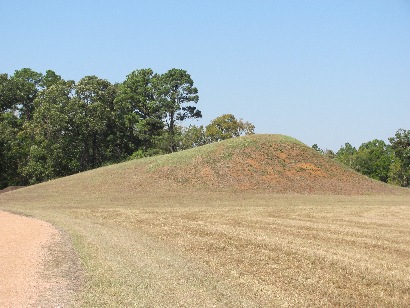Blue Highways: Austin, Texas
Unfolding the Map
Click on Thumbnail for MapNon-Texans may not agree, but there is a little bit of heaven perched on the edge of the desert in Texas - Austin (and San Antonio, where I lived). William Least Heat-Moon notes Austin on his way past, since he doesn't want to spend time in the urban areas. But we'll take a little stop so I can reminisce about Austin and traveling up there a few times a year to do and see interesting things. Click on the map thumbnail at right and see just how far we are across Texas, and how far we have to go.
Book Quote
"At Austin, on a hill west of the Colorado River - not the Colorado River, but the one flowing from near the New Mexico line to the Gulf - the desert began. Desert as in dry, rocky, vast. There was nothing gradual about the change - it was sudden and clear. Within a mile or so, the bluebonnets vanished as if evaporated, the soil turned tan and granular, and squatty trees got squattier with each mile as if reluctant to reach too far from their deep, wet taproots."
Blue Highways: Part 4, Chapter 5
 Austin, Texas. Photo by Rhea Thomas at uptake.com. Click on photo to go to host site.
Austin, Texas. Photo by Rhea Thomas at uptake.com. Click on photo to go to host site.
Austin, Texas
Every so often, my wife and I would leave San Antonio in the early evening and head up to Austin. It was about an hour and a half drive up I-35 to downtown Austin, but usually we would hit some traffic on the outskirts of Austin just before we crossed Town Lake into the downtown. After leaving the downtown skyline of San Antonio, muted in the fading light, the lights of the buildings of Austin reflecting off of the waters made for an interesting contrast with San Antonio.
Perhaps our goal was to have an evening at one of Austin's many good restaurants. Perhaps there was an event, like a concert, that we wanted to see. Sometimes it was the opera that beckoned us. We had season tickets to the Austin Opera and only missed one - when it was too icy to drive and we had to turn back because, even though we were used to plows and salt and sand trucks in the Midwest, they had few of these in the South and even worse, people did not know how to drive in icy conditions.
Once we went to Austin to see the bats fly out from the Congress Avenue Bridge. Austin, if I remember correctly, has the largest urban Mexican red-tailed bat population in the United States They roost under the Congress Avenue Bridge for a certain amount of months each year, and quite a crowd gathers when they fly out in the evenings to look for a meal. We stood under the bridge, listening to the barely audible squeaks of the bats, and soon, a few flew out, followed by an ever increasing torrent. They made a cloud over town lake as they flew and swooped chasing down mosquitoes and other insects.
But to us, the jewel of Austin was located in Zilker Park - Barton Springs. Barton Springs is a spring-fed pool straight from the aquifer below the city. The water remains at a constant temperature, around 68 degrees. In the summer, there was no better place to swim. Well, at least I thought so. One could always go up to Lake Travis and the beaches there, including a clothing-optional beach called Hippie Hollow. I never went to any of those places, though. Barton Springs was just my speed.
One of my best memories, though, was leaving Austin late, usually after the opera. We'd drive back to San Antonio usually around midnight. A wonderful public radio show, Blues Before Sunrise, usually came on and went into the wee hours of the morning. At those moments, after having enjoyed a good time in the capital of Texas, driving through the night down I-35, it was easy to forget that we literally sat perched on the edge of the semi-arid desert just to the west. West of Austin and San Antonio one could drive for hours before coming to a city of any consequence - it was 10 hours to El Paso, probably 12 or so to Albuquerque. In between lay a lot of flat scrubland, gradually giving way to Chihuahuan desert to the southwest. But we raced down the interstate, knowing that at the end lay our home in the Mahncke Park area of San Antonio, and our wonderful white dog waiting for us. As the blues played, and my wife slept, sometimes it seemed like a slice of heaven.
For your listening and viewing pleasure, a band from Austin that unfortunately will not be touring any more - the Asylum Street Spankers. Another Austin treasure to be remembered.
If you want to know more about Austin
Austinist (blog)
austinwebpage.com
Austin American-Statesman (newspaper)
Austin Bloggers Metablog
Austin Chronicle (alternative newspaper)
Austin Convention and Visitors Bureau
Austin Daily Photo (blog)
Austin Food Carts
Austin Food Reviews
Austin History Center
Daughters of the Republic of Texas
Slow Food Austin
University of Texas at Austin
Wikipedia: Austin
Wikipedia: History of Austin
Wikitravel: Austin
Next up: Johnson City, Texas




 Tuesday, February 1, 2011 at 5:22PM
Tuesday, February 1, 2011 at 5:22PM


